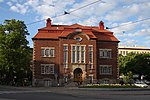Hakaniemi market hall
HakaniemiMarket hallsShopping centres in Helsinki

The Hakaniemi market hall (Finnish: Hakaniemen kauppahalli, Swedish: Hagnäs saluhall) is a market building at the Hakaniemi market square in the district of Kallio in Helsinki, Finland. It was built at the start of the street Hämeentie in 1914.The market hall has undergone basic reparations since March 2018 and the reparations are due to be finished in autumn 2022. During the reparations, the market operates at a heated temporary building, which is due to be dismantled once the reparations are complete.
Excerpt from the Wikipedia article Hakaniemi market hall (License: CC BY-SA 3.0, Authors, Images).Hakaniemi market hall
Hämeentie, Helsinki Kallio (Central major district)
Geographical coordinates (GPS) Address Website External links Nearby Places Show on map
Geographical coordinates (GPS)
| Latitude | Longitude |
|---|---|
| N 60.18 ° | E 24.951111111111 ° |
Address
Hakaniemen kauppahalli
Hämeentie 1 a
00530 Helsinki, Kallio (Central major district)
Finland
Open on Google Maps










